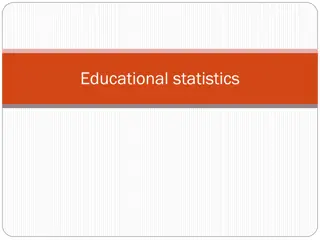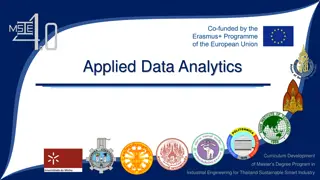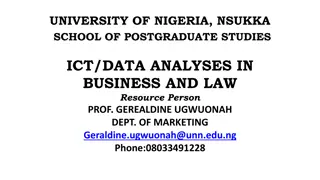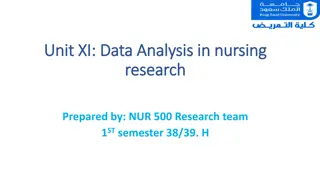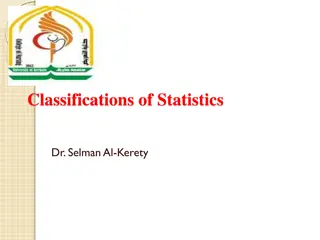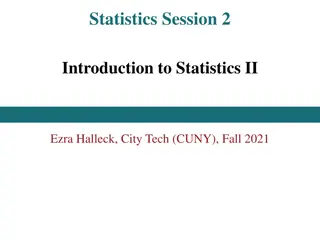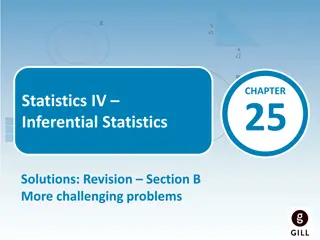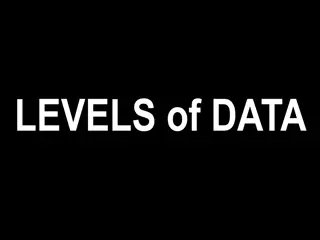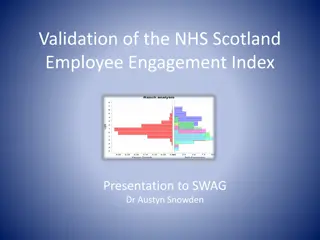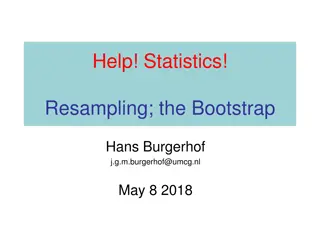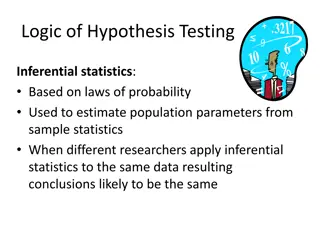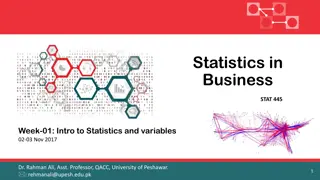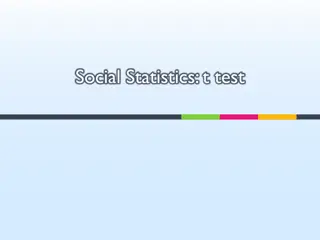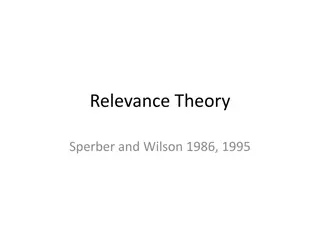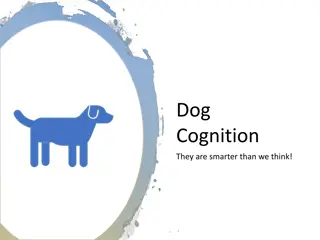The Nature of Probability and Statistics
Branches of statistics, the concept of data, and the selection of samples. It explains variables and data sets, and the difference between descriptive and inferential statistics.
19 views • 14 slides
Inferential Statistics
Hypothesis testing is a key aspect of inferential statistics, allowing researchers to make conclusions about populations based on sample data. This process involves formulating hypotheses, conducting experiments, and determining the probability of results under different scenarios. By comparing the
0 views • 28 slides
Applied Statistics in Psychology: Bridging Theory and Research
This course focuses on teaching applied statistics in psychology, with an emphasis on inferential statistics such as t-tests, ANOVA, correlation, regression, and chi-square. Real-world examples, diversity research, and connections to research methodology are highlighted throughout the course to enha
0 views • 23 slides
Week Sept. 12-16: Inferencing Activities for Learning Development
Explore a week of activities focused on inferencing and learning development, featuring mindful moments, guided practice, and concept/skill development. Engage in asking and answering literal and inferential questions to enhance comprehension skills.
4 views • 41 slides
Exploring Dickens' Presentation of Christmas in English Literature Easter Revision 2018
Charles Dickens' use of descriptive language and symbolism in the extract portrays Fezziwig as a jovial and secure character, contrasting with Scrooge's miserly demeanor. Through single-word analyses and inferential exercises, students can delve deeper into the themes of wealth, contentment, and joy
0 views • 8 slides
Understanding Sampling Methods and Errors in Research
Sampling is crucial in research to draw conclusions about a population. Various methods like simple random sampling, stratified sampling, and systematic sampling help in selecting representative samples. Sampling error arises due to differences between sample and population values, while bias leads
0 views • 12 slides
Understanding Educational Statistics: Key Concepts and Calculations
Statistics is the science of collecting, describing, and interpreting data. It involves two main areas - Descriptive Statistics for organizing and presenting data and Inferential Statistics for drawing conclusions about populations. An example scenario demonstrates the terms like population, sample,
1 views • 35 slides
Understanding Basic Statistics in Research and Evidence-Based Practice
Basic statistics play a crucial role in research and evidence-based practice. Descriptive statistics help summarize data, while inferential statistics make inferences about populations based on samples. Various types of statistics like hypothesis testing, correlation, confidence intervals, and signi
3 views • 15 slides
Applied Data Analytics Curriculum Development for Sustainable Smart Industry in Thailand
This curriculum development session focuses on basic concepts of statistics, covering population vs. sample, census, descriptive vs. inferential statistics, and methods for summarizing data using tabular, graphical, and numerical techniques. The session includes examples and visual representations t
0 views • 72 slides
Workshop on Data Analysis in Business and Law at University of Nigeria, Nsukka
This workshop at the University of Nigeria, Nsukka focuses on data analysis in business and law, covering topics such as measurement, scaling, data preparation, analysis, and interpretation. Participants will learn about the importance of data integrity, statistical tools, and the benefits of ICT in
4 views • 21 slides
Exploratory Data Analysis and Descriptive Statistics in Statistical Analysis
Exploratory Data Analysis involves understanding data characteristics through visualization techniques like bar graphs, pie charts for qualitative data and histograms, scatterplots for quantitative data. It includes calculating mean, median for center, range, standard deviation for spread, and ident
0 views • 7 slides
Understanding Data Analysis in Nursing Research
Data analysis in nursing research involves rendering individual data points into meaningful information, leading to knowledge generation. The process includes qualitative and quantitative analysis to organize and interpret data effectively. Techniques such as data reduction, data display, and conclu
2 views • 26 slides
Statistical Analysis: Descriptive and Inferential Techniques Overview
Understanding statistical analysis involves both descriptive and inferential techniques. Descriptive statistics focus on summarizing data, including measures of central tendency and dispersion. In contrast, inferential statistics use sample data to make inferences about populations and test hypothes
0 views • 19 slides
Different Classifications and Guidelines for Descriptive Statistics
This content discusses the two broad classifications of statistics - descriptive and inferential. It delves into descriptive statistics, which help organize and summarize numerical data, and explores various ways to categorize them. It covers measures to condense data, central tendency, variability,
0 views • 26 slides
Introduction to Statistics: Descriptive and Inferential Methods
Statistics involves collecting, analyzing, and interpreting data to make decisions. It includes descriptive methods to organize data and inferential methods to predict outcomes. Basic terms like elements, variables, and observations are vital in statistical analysis. The total wealth of the world's
0 views • 25 slides
Inferential Statistics Solutions for Challenging Problems in Section B
The provided statistical problems in Section B involve calculating the expected number of shoppers spending specific durations at a furniture shop and reasons for not checking the weight of each packet when filling corn flakes. Solutions include determining the shoppers expected to spend more than 4
0 views • 25 slides
Understanding Levels of Data and their Relationship to Graphs and Statistics
Exploring the levels of data, relationship to graphs and statistics, independent and dependent variables in experiments, types of controlled variables, conclusions drawn, and inferential statistics used. The content discusses various types of data levels, graph types, statistical analyses, and exper
0 views • 4 slides
Validation of NHS Scotland Employee Engagement Index Presentation
This presentation covers the validation process of the NHS Scotland Employee Engagement Index presented to SWAG Dr. Austyn Snowden. It includes an overview of the NHSEEI, bespoke sample and assumptions, descriptive and inferential statistics, and conclusions and recommendations based on the data col
0 views • 34 slides
Understanding Resampling Techniques in Statistics
Explore the concept of resampling through methods like the Bootstrap, permutations, combinations, and parametric inferential statistics. Discover how resampling offers robust and relevant insights, and when to use it. Delve into the basics of permutations and combinations, and learn how to apply the
0 views • 35 slides
Understanding Inferential Statistics and Hypothesis Testing in Research
Inferential statistics in research involve estimating population parameters from sample statistics and making decisions based on probability. Researchers follow a set process, starting with preparing for a study, defining variables, stating hypotheses, selecting appropriate tests, analyzing data, an
0 views • 30 slides
Introduction to Statistics in Business: Key Concepts and Methods
Explore the fundamental concepts in statistics for business purposes, including descriptive and inferential statistics, populations and samples, types of variables, and the importance of statistical analysis. Dr. Rahman Ali, Assistant Professor at the University of Peshawar, delves into the meaning
0 views • 40 slides
Understanding the Basics of t-Test in Social Statistics
Explore the significance of the t-test for inferential statistics, its types, and why it is preferred over the z-test in many cases. Learn about William S. Gossett's contribution to the development of the t-test and understand concepts like degrees of freedom. Delve into practical applications with
0 views • 31 slides
Understanding Relevance Theory: Sperber and Wilson's Approach
Relevance Theory, introduced by Sperber and Wilson in 1986, aims to explain how propositions are understood without relying on mutual knowledge. It addresses deixis, ellipsis, vagueness, and ambiguity while exploring implicatures and providing a general theory of communication beyond just verbal int
0 views • 38 slides
Unveiling the Intelligence of Dogs: A Closer Look at Dog Cognition
Dogs possess remarkable cognitive abilities that surpass common beliefs. With a strong capacity for social and nonsocial learning, discrimination, contingency reversal, object permanence, categorization, and inferential learning, dogs exhibit behaviors indicative of advanced cognitive-emotional capa
0 views • 35 slides






